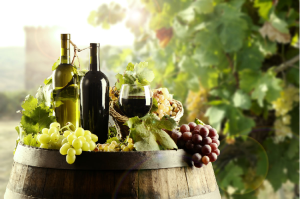
07 Nov Four different ways of making wine: you decide
Wanting to explain, in broad strokes, the different ways of making wine (and before going into the details of each one of them), all of them, excluding the one from conventional agriculture, tend towards one point: the null or the minimum intervention. Sulfites, one of the many substances most abundant in conventional wine, act as a preservative for wine; a substance that is added so that the wine does not spoil but that also stops its growth in all senses.
For the most part, producers of natural, biodynamic or organic wines intend to produce sulfite-free wines. Each winemaker, in his own way, tries to take this philosophy to the maximum of its “purity”. Some manage to intervene little and some do not intervene directly, because doing their job without any chemical intervention has its drawbacks but also many qualitative advantages. The color, smell, and taste of these wines are very different from those of conventional wines because the wine continues to evolve and develop inside the bottle.
Understanding and appreciating this type of wine, when what we have in mind -and in the mouth- is the taste of conventional wine – chemically treated – also means an enormous discovery, in every way, for those who taste it.
We understand the different ways of making wine:
Conventional Wine
It is the wine that comes from industrial or integrated agriculture. The grapes to make these wines generally come from large areas, treated with herbicides or pesticides, industrial fertilizers, copper, sulfur, and other substances without clearly regulating their dosage.
Overproduction can cause the grape to be harvested mechanically and in the winery, it can be treated in its process to make it wine with various oenological techniques and through chemical processes to obtain a certain aromatic profile, color and flavor.
Conventional wine may contain in minimal doses: tartaric acid, oenological tannin, enzymes, malic acid, gum arabic, colloidal silver, lactic acid bacteria, pepsin, pectin, sorbitol potassium, gelatin, casein, creatine, folic acid, nitric acid, urease, potassium ferrocyanide, isinglass and other sulfides in a proportion ranging from 200 mg/l to 300 mg/l. If the manufacturers of this type of wine were required to name all this on their label, it would practically be a “pharmaceutical package insert”.
Now, if we start from a grape full of life that has grown without chemical products on its land, with native yeasts from the skin of the grape and all the microorganisms around it, and as long as it is not subjected to any process that alters its nature, then there is no reason to resort to chemical products to regulate it or sulfites. A wine made in this way, and with a healthy grape, will have its natural preservatives, mainly tannins, alcohol, and acidity.
Organic Wine

In Europe, for a wine to be considered organic, it must meet the legal requirements imposed by said certification, as regulated at the community level: it is necessary to follow green practices in the different production processes (from cultivation to the cellar) and requires the corresponding official certificate or logo on the bottle.
Generally, organic wine respects the natural rhythm of the vine and uses the same ecosystem to avoid the use of chemical fertilizers and pesticides.
The regulation establishes the oenological techniques and substances authorized for the purpose of organic wine production. Among them, the maximum content of sulfite stands out, which is set at 100 mg/l for red wine (150 mg/l for conventional wine) and at 150 mg/l for white or rosé wine (200 mg/l for conventional), with a differential of 30 mg/l when the residual sugar content is greater than 2 g per liter.
The land where the vines are must be fertilized with organic fertilizers, especially those that are of vegetable origin from the residues of the crop itself, such as pomace or crushed vine shoots. But synthetic fertilizers are also allowed, different types of filtering are allowed and copper and sulfur treatments are carried out in the soil in a fairly generous figure (6kg/ha), and at the same time, certain types of “eco” fertilizers are allowed. to pay for the land.
Biodynamic Wine
Coming from biodynamic agriculture, a method based on the theories of Rudolf Steiner, founder of anthroposophy. The certification of the products and the obtaining of the registered trademark “ Biodynamics ” belongs to the private group Démeter.
This type of agriculture considers farms as complex organisms. It emphasizes the interrelation between soils, plants, and animals, treating the whole as a system in balance, avoiding as far as possible external interventions, and taking into account the loss of nutrients due to the departure of crops and other products outside the farm.
As in other forms of organic farming, the use of industrial fertilizers, pesticides, and herbicides is avoided, the use of copper and sulfur being allowed in very low doses (2 or 3kg/h) and in extreme cases.
Biodynamic wine can contain sulfites (many do not contain them and in others we speak of 30 or 40mg/l, being very rare to find one that exceeds 70mg/l) and can be filtered (since they are not essential requirements for the parameters of biodynamics). When talking about biodynamic wine, we must bear in mind that it is not only a type of wine but also a philosophy of life in which science, work, and natural self-sustainability are combined in a full connection with the earth.
Natural Wine
It is what is called “wine without additives of any kind” that is obtained with the minimum possible intervention, both in the cultivation of the vineyards and in the production process in the cellar and its transformation into the final product that we drink bottled.
The definition of natural wine generates many debates: there is no “legal” or “academic” definition that we can use as a ” dogma “, nor does it seem that this is the main concern of artisans in the field. On the contrary, there is an important cohesion within the sectors that defend the most radical line when it comes to growing grapes and making wine. The label “natural” is the word most used by all of us who spread internationally about this way of making wine since it is the only way to differentiate ourselves until now.
“Natural” wine may or may not be certified by competent bodies in each country of origin, but what is clear is that these wines are only made with grapes, without filtering, clarifying, stabilizing, or adding any type of chemical (before, during or after all the processes ), with minimal human intervention in them, that is, tilling as little as possible, picking the grapes by hand, etc.
You may like to read How does alcoholism affect (bad impact) adolescents?

Sorry, the comment form is closed at this time.